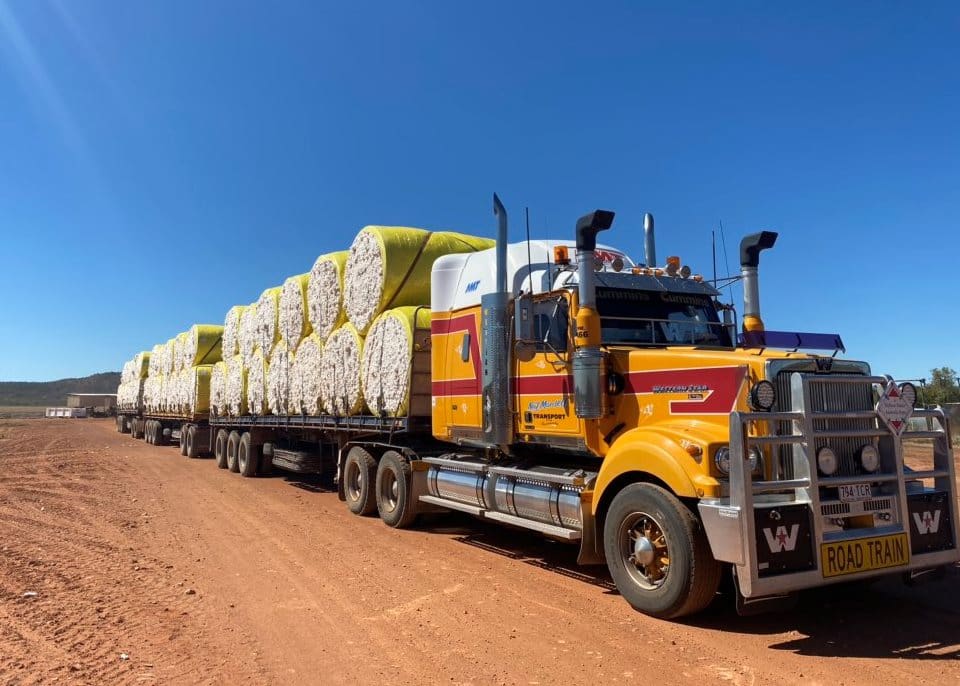
Cotton grown in the Ord is currently trucked to Queensland for ginning because northern Australia is yet to get its own facility. Photo: Luke McKay
CONSTRUCTION of a cotton gin at Kununurra in Western Australia’s East Kimberley region appears increasing likely following the WA Government’s allocation earlier this month of close to $4 million for the project.
A total of $3.5M will support the installation and upgrade of a high-voltage line and network to supply clean renewable power from Pac Hydro’s Lake Argyle generation system to the proposed site for a cotton gin on Mulligans Lagoon Road.
A further $481,000 has been allocated to progress preliminary design work and approvals for the cotton gin.
A gin in Kununurra will negate the need to truck cotton being grown in the Ord region to Queensland, where the nearest operating cotton gins are located.
A recent study indicated a new cotton gin could create more than 1000 local jobs in its first 10 years, generating $1.19 billion in cotton lint exports, and additional benefits from retaining cottonseed as feed for the local cattle industry.
Cotton trials in the Ord River Irrigation Area over the past four years using the Bollgard3 variety, with improved pest and disease resistance, have proven successful, with 1200 hectares grown across the irrigation area in 2020.
The WA Government has actively supported efforts to build a sustainable cotton industry in the Ord, with a group of local investors led by the Ord River District Co-operative (ORDCO), Kimberley Agricultural Investment Pty Ltd and the MG Corporation.
This latest commitment is in addition to a State Government Value Add Agribusiness Investment Attraction Fund grant to ORDCO last year to assist the development of a business model and governance arrangements for the cotton gin.
WA Premier Mark McGowan said the funding will ensure a reliable, efficient, clean power supply for the Kimberley cotton gin using hydroelectricity with zero carbon emissions, highly desired by the discerning global marketplace, to increase the competitiveness of the business.
“I look forward to seeing this vision realised and the enduring economic growth and jobs it will create for the East Kimberley and beyond,” Mr McGowan said.
“With the State Government, growers and traditional owners working towards this shared vision, we are confident we can get a cotton gin off the ground in Kununurra, and this funding is a major step forward,” WA Agriculture and Food Minister Alannah MacTiernan said.
“Commercial cotton trials demonstrate the Ord region can grow a high-quality high-yielding crop, which has given local growers confidence to push ahead with establishing a sustainable cotton industry including local processing.
“We have seen fantastic collaboration between the East Kimberley groups involved in this project, including growers and traditional owners, working towards a common goal to bring transformational economic and social benefits to the region for generations to come.”
Source: WA Government
Resurgent industry
Cotton was first grown in the Ord from the mid 1960s to the mid 1970s, but an inability to control insects and produce good-quality fibre saw it flounder and fail.
The release of bio-transgenic (Bt) cotton in the 1990s saw the Ord revisit cotton in the hope the variety could resist insect pressure, and Kununurra’s first gin was opened in 1997 as a joint venture between Colly Cotton and the Ord River Co-operative.
In that year, the Ord grew 250ha of Bt cotton, but again, the crop succumbed to insect pressure, and growers switched to other crops.
Sugarcane was also grown successfully from the mid 1990s to around 2007, and was crushed at a mill built in Kununurra, but the industry petered out, largely due to market forces.
Since 2000, Ord growers have planted tree crops including mango, citrus and sandalwood, horticultural crops including melons and pumpkin, and row-crops like chickpeas and chia.
Improved agronomy has seen confidence grow in growing corn and cotton, and three-gene Bt cotton grown today makes the crop resistant to insect pressure, and a proven performer in all environments.
The region has an average cotton yield of about 10 bales per hectare, and could be ginning cotton in Kununurra as early as 2023.
Grain Central: Get our free cropping news straight to your inbox – Click here

HAVE YOUR SAY